中国八大菜系(英文版)
- 格式:docx
- 大小:1.09 MB
- 文档页数:8
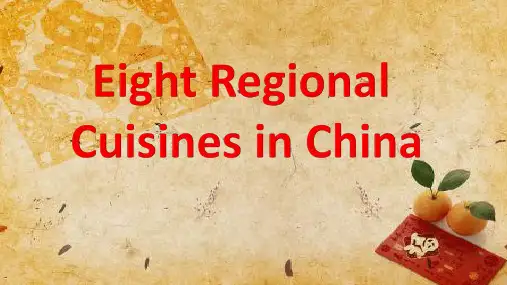

八大菜系英文介绍以下是八大菜系的英文介绍:1. 鲁菜:Shandong Cuisine, also known as Lu Cuisine, is the representative cuisine of the North and Northeast China, with a focus on seafood, pork, and chicken. It is known for its simple cooking methods, fresh ingredients, and rich flavors.2. 川菜:Sichuan Cuisine, also known as Chuan Cuisine, is a spicy and pungent cuisine from Sichuan Province in China. It is famous for its fiery peppers and rich sauces, and often features pork, chicken, and seafood.3. 粤菜:Cantonese Cuisine is the representative cuisine of Guangdong Province in China, known for its freshness, simplicity, and unique seasonings. It emphasizes the use of high-quality ingredients and pays attention to the presentation of dishes.4. 闽菜:Fujian Cuisine is a coastal cuisine from Fujian Province in China. It emphasizes seafood, fresh vegetables, and rice dishes. The cooking methods are unique, with a focus on stewing, steaming, and deep-frying.5. 苏菜:Jiangsu Cuisine is a representative cuisine of the Yangtze River Delta region in China. It emphasizes freshness, tenderness, and mild flavors. The cooking methods are diverse, including stewing, steaming, frying, and braising.6. 浙菜:Zhejiang Cuisine is a representative cuisine of the eastern region of China, known for its simplicity and unique flavors. It often features rice dishes, seafood, and various kinds of meat. The cooking methods include stewing, steaming, and frying.7. 湘菜:Xiang Cuisine is a spicy and pungent cuisine from Hunan Province in China. It emphasizes the use of fresh ingredients and fiery peppers, often featuring pork, chicken, and beef. The cooking methods include stewing, steaming, and deep-frying.8. 徽菜:Anhui Cuisine is a traditional Chinese cuisine from Anhui Province, known for its unique flavors and seasonings. The main ingredients include pork, chicken, duck, and various kinds of vegetables. The cooking methods include stewing, steaming, frying, and braising.。
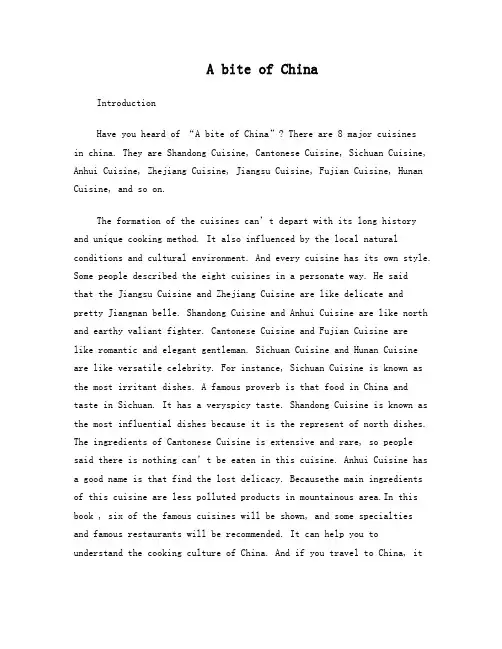
A bite of ChinaIntroductionHave you heard of “A bite of China”? There are 8 major cuisinesin china. They are Shandong Cuisine, Cantonese Cuisine, Sichuan Cuisine, Anhui Cuisine, Zhejiang Cuisine, Jiangsu Cuisine, Fujian Cuisine, Hunan Cuisine, and so on.The formation of the cuisines can’t depart with its long history and unique cooking method. It also influenced by the local natural conditions and cultural environment. And every cuisine has its own style. Some people described the eight cuisines in a personate way. He saidthat the Jiangsu Cuisine and Zhejiang Cuisine are like delicate andpretty Jiangnan belle. Shandong Cuisine and Anhui Cuisine are like north and earthy valiant fighter. Cantonese Cuisine and Fujian Cuisine arelike romantic and elegant gentleman. Sichuan Cuisine and Hunan Cuisine are like versatile celebrity. For instance, Sichuan Cuisine is known as the most irritant dishes. A famous proverb is that food in China and taste in Sichuan. It has a veryspicy taste. Shandong Cuisine is known as the most influential dishes because it is the represent of north dishes. The ingredients of Cantonese Cuisine is extensive and rare, so people said there is nothing can’t be eaten in this cuisine. Anhui Cuisine has a good name is that find the lost delicacy. Becausethe main ingredients of this cuisine are less polluted products in mountainous area.In this book , six of the famous cuisines will be shown, and some specialtiesand famous restaurants will be recommended. It can help you to understand the cooking culture of China. And if you travel to China, itcan help you to choose your favorite food. So you can have a cate enjoyment. Now, let’s open the gate of Chinese Cuisines.Shandong Cuisine (July)Shandong Cuisine, which is originated from Shandong flavor, always clean, pure, and not greasy. Shallot and garlic are two main seasonings of the dishes, so Shandong Cuisine usually tastes pungent. It emphasizes on tenderness, crispness and freshness. Jinan cuisine and jiaonan cuisine are the two main parts of Shandong Cuisine. Jinan cuisine characterizes by deep-frying and stir-frying, grilling, and stir-frying while jiaonan cuisine focuses on cooking food with light taste. Soups are very famous in Shandong Cuisine. If you have a try, you will find that thin soup tastes fresh and creamy soup tastes strong.Shandong is the birthplace of cooking culture, and there ever existed many famous ancient scholars, such as Confucius and Mencius. As old as the ancient scholars, Shandong Cuisine also has a long history. It originated in the Spring and Autumn period , and formed during Qin and Han Dynasty. After Song Dynasty, it became the represent of “the North dishes”. Shandong cuisine is one of the major eight Chinese cuisine and it is the local cuisine that covered most extensive area in China, include Beijing, Tianjin and Dongbei Province.Shandong Province is known as the origination of ancient culture in China. The formation of Shandong Cuisine has a tight connection with the local history, geographical conditions, economic conditions and customs. This province is also known as one of world’s three gardens. For example, jiaozhouChinese cabbage, Zhangqiu garlic, Cangshan shallot are famous in abroad.There are too many Shandong Cuisine restaurants in china. The most famous restaurants includeQilurenjia, Beijing Qilu Restaurant and Tongheju.Cantonese Cuisine(Asiya)Cantonese Cuisine is one of the eight culinary traditions of Chinese cuisine. When westerners speak of Chinese food, they usually refer to Cantonese Cuisine. Why? This is because of the most Chinese who immigrant and set up restaurants overseas were from Guangdong. Now, let me introduce this kind of cuisine. Guangzhou, the capital of Guangdong province, has long been a trading port and many important food. Unlike other Chinese cuisine style of cooking, Cantonese Cuisine more attention to bring out or highlight the original taste of the meet, vegetable. unlike Sichuan Cuisine so spicy, unlike other foods lost original taste of cooking, so Cantonese Cuisine is a little spice or sugar is used generally.Common Cantonese Dishes for you.These dishes are often simple and easy to learn to cook, and they came the most common foods on the menus of Cantonese restaurants.Chinese steamed eggs: there are by beating eggs to a creamy consistency and steaming till this water boiling. Variations are derived by colding different ingredients, such as onion and soy sauce.Noddle dishesShahe noodles are a kind of rice noodles, they are broad and look white, their texture is elastic and like a little chewy. They don’t freeze or drying and should generally purchased fresh in strips that should be cut to the desired width. Shahe noodles are popular in southern china.Meat Dishes.We should boil the chicken in water until the chicken looks golden. When it is cook done, the chicken tastes fresh and maintain original taste of chicken.Seafood.Because Guangdong located on the southern of china, fresh seafoodis easy to available to get and many Cantonese restaurants are best use of this advantages. In Cantonese culinary arts, steaming is best cooking style. According to Cantonese Cuisine, the taste fresh is the most important point, so seafood generally cooked by steaming.Cantonese are known to us that they try different kind of meats and vegetables. So, people those who are in Northern China often says that Cantonese people will eat anything that flies except airplanes, anything that moves on the ground except train, and everything that moves in the water except boats.Panxirestaurant in Guangzhou.Address: 151 west longjin road, Liwan District. Lung king HeenAddress: IFC Tower, 8 Finance st, Hong Kong.Zhejiang cuisine(Clark)Zhejiang cuisine also called ZheCai for short, is one of the eight major cuisines of China. Zhejiang cuisine has it’s unique taste and uniquecooking method. It’s because that Zhejiang province be rich in natural resources. Zhejiang province closed to sea, so Zhejiang cuisine is good at making sea food, and Zhejiang province also is the main place that product meat and rice, so the meat also is the Zhejiang cuisine’s material. So Zhejiang cuisine’s cooking methods mainly are sautéing, stir-frying, simmering and steaming, obtaining the natural flavor and taste. Zhejiang cuisine, not greasy, wins its reputation for freshness, tenderness and smoothness of its dishes with mellow fragrance.Zhejiang cuisines include Hangzhou food, Ningbo food and Shaoxing food. Hangzhou, Ningbo and Shaoxing are all in ZhejiangProvince. Hangzhou food is the most famous cuisine in the Zhejiang cuisine.Hangzhoufood tastes fresh and crisp, and with the change of season it also has different kinds of food. And the main cooking methods of Hangzhou food are sautéing stewing, deep-frying and steaming. Ningbo food is a bit salty but delicious. And Ningbo food is good at steaming,roasting and braising seafood, so Ningbo food famous by retaining original freshness, tenderness and softness. Shaoxing food known asit’s aquatic food and poultry. Sha oxing food has a unique village flavor, smell sweet taste soft and glutinous, thick in gravy and strong in season.Zhejiang cuisine specializes in stir-frying, steaming, deep-frying and simmering, obtaining the natural flavor and taste. And Zhejiang province has full of materials, and people take special care in cooking, so Zhejiang cuisine is so delicious and be famous in China.Anhui Cuisine (Angenla)Anhui cuisine, together with Shan dong cuisine, Sichuan cuisine, Cantonese cuisine, Zhejiang cuisine and Jiangsu cuisine are all belonged to Chinese royal dishes from Qin dynasty. They all pay attention to the cultured colors and fresh materials.It is said that the emperor Yuan collected public opinions from Anhui and Zhejiang provinces when he unified southern China in 221B、C. He happened to be invited to a village when he passes by Anhui province. Although the villagers did not recognize his identify, they treated him with generous hospitality and did him a meal with fresh seafood and home-made chili sauce. When the emperor Yuan came back to the capital, he missed that taste and the people there. To memorize villagers’ kindness and this moved experience, he named it Hui cuisine and listed Anhui cuisine as one of the eight major components of Chinese cuisine.The most famous dish of Anhui cuisine called “Boiled fish”. They put the raw fish into boiled chili oil and add green onion, ginger, garlic and soy to it. Wait your raw ingredients are slow-cooked in a safe, enclosed cooker for 20minutes and a delicious boiled fish is born!Have a taste, you can feel the fish with hot sauce is melted in your mouth.Southern cuisines like to use seafood and chilies to make the foods have strong taste. Similarly,traditional Anhui cuisine as a part of southern cuisine also use fierce ingredients to awakening thegastricfire .On completely contrast, northern cuisine ,like Shandong cuisine are light and use chilies and pepper as less as they can.However, because of the big differences between southern cuisines and northern cuisines, Chinese dietary culture appears to be rich and varied.Jiangsu Cuisine(Belle)Jiangsu cuisine, which is abbreviated to su cuisine, is one of the eight cuisines of Chinese mainly nationality. It was invented two thousand years ago. Jiangsu cuisine is similar to the Zhejiang cuisine. They are both also called the land of fish and rice because of the much water there. Jiangsu province and Zhejiang province are located in the south of China and beside the sea, so there are a lot of rainfall in Jiangsu and Zhejiang. Therefore, some delicious food is made of fish in Jiangsu and Zhejiang province. On the other hand, Jiangsu cuisine is different from Zhejiang and the other places. Its characteristic is thick with light, crisp and fresh juice broth strong but not greasy, gentle, salty and sweet. The cookers in Jiangsu are good at stewing, braising, burning, heating and frying. In addition, they are skilled in cooking soup that taste very fresh. What is the most representative are Suzhou dish, Yangzhou dish, Nanjing dish and Zhenjiang dish. Suzhoufood taste sweet and its color slants harmony. Yangzhou cuisine haslight material, fine mellow flavor and knife labor. Nanjing and Zhejiang dish focus on alcohol which make the dishes have exquisite dainty, especially in the prestigious duck dishes. In a word, Jiangsu cuisine is famous for its colorful selection of ingredients, its meticulous preparation methodology and its not-too- bland taste.。
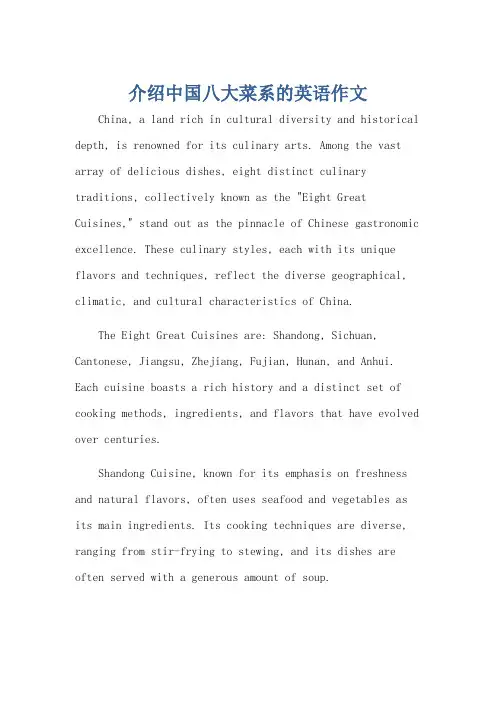
介绍中国八大菜系的英语作文China, a land rich in cultural diversity and historical depth, is renowned for its culinary arts. Among the vast array of delicious dishes, eight distinct culinary traditions, collectively known as the "Eight Great Cuisines," stand out as the pinnacle of Chinese gastronomic excellence. These culinary styles, each with its unique flavors and techniques, reflect the diverse geographical, climatic, and cultural characteristics of China.The Eight Great Cuisines are: Shandong, Sichuan, Cantonese, Jiangsu, Zhejiang, Fujian, Hunan, and Anhui. Each cuisine boasts a rich history and a distinct set of cooking methods, ingredients, and flavors that have evolved over centuries.Shandong Cuisine, known for its emphasis on freshness and natural flavors, often uses seafood and vegetables as its main ingredients. Its cooking techniques are diverse, ranging from stir-frying to stewing, and its dishes are often served with a generous amount of soup.Sichuan Cuisine, famous for its spicy and numbing flavors, uses a generous amount of chili peppers and peppercorns. Its complex flavors are achieved through the skillful use of various cooking techniques, such as dry-frying, steaming, and braising.Cantonese Cuisine, known for its delicate flavors and intricate preparation methods, often uses fresh seafood, poultry, and vegetables. Its cooking techniques emphasize the retention of the original flavors of the ingredients, often through steaming, roasting, or stir-frying.Jiangsu Cuisine, characterized by its light and refreshing flavors, often uses river seafood, poultry, and vegetables. Its cooking methods are subtle and precise, with a focus on preserving the natural taste and texture of the ingredients.Zhejiang Cuisine, similar to Jiangsu Cuisine in its emphasis on freshness and delicacy, often uses seafood and river products. Its dishes are known for their intricate presentation and harmonious blend of flavors.Fujian Cuisine, with its unique blend of seafood and mountain produce, offers a diverse array of flavors andcooking techniques. Its dishes often incorporate the use of unique ingredients and seasonings, reflecting the rich biodiversity of Fujian province.Hunan Cuisine, known for its spicy and sour flavors, often uses chili peppers and vinegar to create its signature taste. Its cooking methods are diverse, including stir-frying, stewing, and smoking, and its dishes are often served with a generous amount of chili oil.Anhui Cuisine, with its emphasis on heavy flavors and the use of unique ingredients, offers a rich and satisfying culinary experience. Its dishes often incorporate the use of preserved foods and wild herbs, giving them a distinctively earthy flavor.The Eight Great Cuisines of China represent the rich tapestry of Chinese culinary arts. Each cuisine offers a unique gastronomic journey, allowing one to explore the diverse flavors, techniques, and traditions of this ancient and vibrant nation. Whether you're a food lover or simply curious about Chinese culture, a journey through the Eight Great Cuisines is sure to be an unforgettable experience. **中国八大菜系:美食之旅**中国,这片文化多元、历史悠久的土地,以其卓越的烹饪艺术闻名于世。

Chinese cuisine(中國菜) originated from the various regions of China and has become widespread in many other parts of the worldRegional cultural differences vary greatly amongst the different regions of China, giving rise to the different styles of food. There are eight main regional cuisines, or Eight Great Traditions (八大菜系): Anhui, Cantonese, Fujian, Hunan, Jiangsu, Shandong, Sichuan, and Zhejiang. Occasionally, Beijing cuisine and Shanghai cuisine are also cited along with the eight regional styles as the Ten Great Traditions (十大菜系).Anhui cuisine(徽菜) is derived from the native cooking styles of the Huangshan Mountains region in China and is similar to Jiangsu cuisine.Anhui cuisine is known for its use of wild game and herbs, both land and sea, and simple methods of preparation. Braising and stewing are common techniques. Frying and stir-frying are used much less frequently in Anhui cuisine than in other Chinese culinary traditions.Some famous dishes include:∙Stewed soft shell turtle with ham∙Steamed stone frog∙Bamboo shoots cooked with sausage and dried mushroom∙Li Hongzhang Hodge-PodgeCantonese (Yue) cuisine draws upon a great diversity of ingredients with many imported foods and ingredients. Besides pork, beef, and chicken, Cantonese cuisine incorporates almost all edible meats, including organ meats, chicken feet, duck and duck tongues, snakes, and snails. Many cooking methods are used, steaming, stir-frying, shallow frying, double boiling, braising, and deep-frying being the most common ones in Cantonese restaurants, due to their convenience and rapidity, and their ability to bring out the flavor of the freshest ingredients.Fujian cuisine(闽菜) is derived from the native cooking style of the province of Fujian, China. Fujian style cuisine is known to be light but flavourful, umami, soft, and tende r, with particular emphasis on showing off and not masking original flavour of the main ingredients.The techniques employed in the cuisine are complex but the results are ideally refined in taste with no "loud" flavours. Particular attention is also paid on the knife skills and cooking techinque of the chefs. Emphasis is also on utilizing soup, and there is a sayings in the region's cuisine: "One soup can be changed in ten forms" (-湯十變) and "It is unacceptable for a meal to not have soup"(不湯不行).popular dishes●"Buddha jumps over the wall" (佛跳墙), a complex dish making use of manyingredients, including shark fin, sea cucumber, abalone, and Shaoxing wine.●yenpi (燕皮), a thin flour wrapper made with large proportions of lean pork. Thiswrapper has a unique texture due to the incorporation of meat and has a "bite"similar to things made with surimi. Yenpi is used to make rouyen (肉燕), a type of wonton.Hunan cuisine, sometimes called Xiang cuisine(湘菜) is well known for its hot spicy flavor, fresh aroma and deep color. Common cooking techniques include stewing, frying, pot-roasting, braising, and smoking. Due to the high agricultural output of the region, ingredients for Hunan dishes are many and varied.A special hot pot called (鸳鸯火锅yuān yāng hǔo gūo) lover's hot pot is famous for splitting the pot into a spicy side and a milder side.∙Dongan chicken∙Mao's braised pork∙Changsha vermicelli∙Steamed fish heads in chili sauce∙Orange beef∙Hot and peppery chicken∙Spare ribs steamed in bamboo∙Changsha-style stinky tofu∙Mashed shrimp in lotus pod∙Xiangdu roast duck∙Sizzling rice soup∙Lotus Seeds in rock sugar syrup∙Pumpkin cake∙Spicy frog leg∙Oxtail porridgeJiangsu cuisine (苏菜) In general, Jiangsu cuisine's texture is characterized as soft, but not to the point of mushy(糊状的)or falling apart. For example, the meat tastes so soft but would not separate from the bone when being picked up. Other characters includes the strict selection of ingredients according to the seasons, emphasis on the matching color and shape of each dish and emphasis on using soup to improve the flavor. Suzhou cuisine: emphasis on the selection of material, stronger taste than Nanjing cuisine, and with a tendency to be sweeter than the other varieties of the cuisine.Shandong cuisine (鲁菜) Shandong cuisine consists of two major styles:Jiaodong style: This style encompasses dishes from Fushan, Qingdao, Yantai and surrounding regions. It is characterized by seafood cooking, with light tastes.Jinan style: This style encompasses dishes from Jinan, dezhou, Tai'an and surrounding regions. It is famed for its soup and utilizing soups in its dishes.Sichuan cuisine (川菜) is famed for bold flavors, particularly the spiciness resulting from liberal use of chilis and "numb" or "tingling" flavor (Chinese: 麻) of the Sichuan peppercorn (花椒). Szechuan cuisine often contains food preserved through pickling, salting, drying and smoking, and is generally spicy. The Sichuan peppercorn is commonly used; Broad bean chili paste (豆瓣醬)is also a staple seasoning in Sichuan cuisine.Common preparation techniques in Sichuan cuisine include stir frying, steaming and braising, but a complete list would include more than 20 distinct techniques. Beef issomewhat more common in Szechuan cuisine than it is in other Chinese cuisines, perhaps due to the widespread use of oxen in the region.Kung Pao chicken宮保雞丁Twice Cooked Pork回鍋肉Fuqi Feipian夫妻肺片Zhejiang cuisine(浙菜) Food made in the Zhejiang style is not greasy, having instead a fresh and soft flavor with a mellow fragrance.The cuisine consists of at least three styles, each originating from a city in the province: the Hangzhou style is characterized by rich variations and the utilization of bamboo shoots, the Shaoxing style specializes in poultry and freshwater fish, and the Ningbo style specializing in seafood, with emphasis on freshness and salty dishes.Some sources also include the Wenzhou style as a separate subdivision, characterized as the greatest source of seafood as well as poultry and livestock. Ningbo cuisine is regarded as rather salty.Dongpo rou, Jiaohua ji(beggar's chicken) and Xi Hu cu yu(West Lake fish in vinegar)。
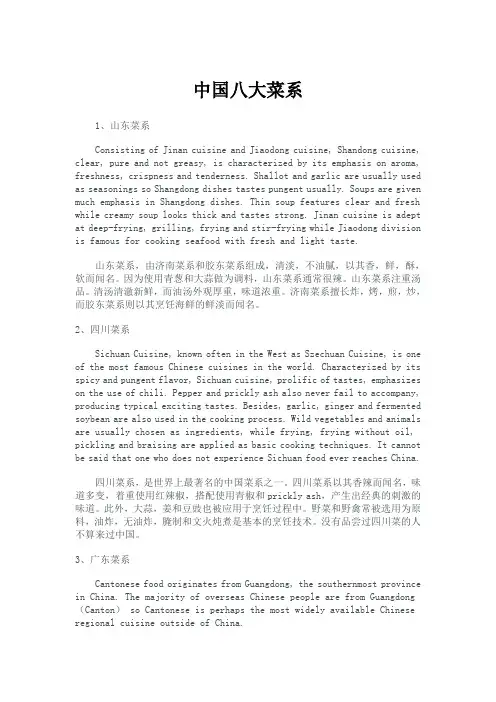
中国八大菜系1、山东菜系Consisting of Jinan cuisine and Jiaodong cuisine, Shandong cuisine, clear, pure and not greasy, is characterized by its emphasis on aroma, freshness, crispness and tenderness. Shallot and garlic are usually used as seasonings so Shangdong dishes tastes pungent usually. Soups are given much emphasis in Shangdong dishes. Thin soup features clear and fresh while creamy soup looks thick and tastes strong. Jinan cuisine is adept at deep-frying, grilling, frying and stir-frying while Jiaodong division is famous for cooking seafood with fresh and light taste.山东菜系,由济南菜系和胶东菜系组成,清淡,不油腻,以其香,鲜,酥,软而闻名。
因为使用青葱和大蒜做为调料,山东菜系通常很辣。
山东菜系注重汤品。
清汤清澈新鲜,而油汤外观厚重,味道浓重。
济南菜系擅长炸,烤,煎,炒,而胶东菜系则以其烹饪海鲜的鲜淡而闻名。
2、四川菜系Sichuan Cuisine, known often in the West as Szechuan Cuisine, is one of the most famous Chinese cuisines in the world. Characterized by its spicy and pungent flavor, Sichuan cuisine, prolific of tastes, emphasizes on the use of chili. Pepper and prickly ash also never fail to accompany, producing typical exciting tastes. Besides, garlic, ginger and fermented soybean are also used in the cooking process. Wild vegetables and animals are usually chosen as ingredients, while frying, frying without oil, pickling and braising are applied as basic cooking techniques. It cannot be said that one who does not experience Sichuan food ever reaches China.四川菜系,是世界上最著名的中国菜系之一。
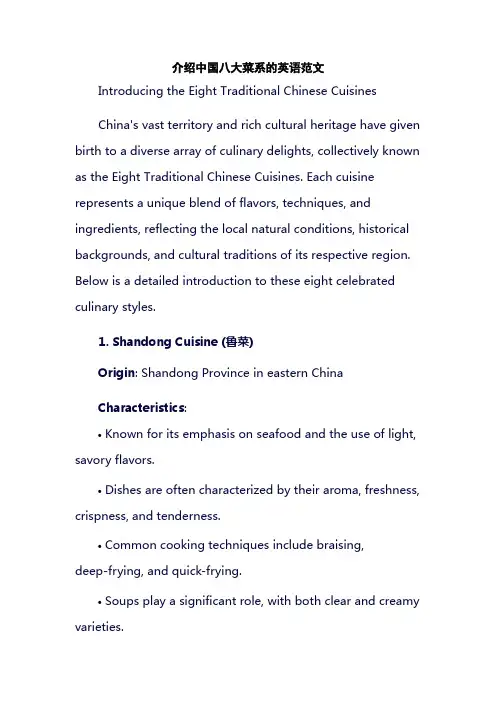
介绍中国八大菜系的英语范文Introducing the Eight Traditional Chinese CuisinesChina's vast territory and rich cultural heritage have given birth to a diverse array of culinary delights, collectively known as the Eight Traditional Chinese Cuisines. Each cuisine represents a unique blend of flavors, techniques, and ingredients, reflecting the local natural conditions, historical backgrounds, and cultural traditions of its respective region. Below is a detailed introduction to these eight celebrated culinary styles.1. Shandong Cuisine (鲁菜)Origin: Shandong Province in eastern ChinaCharacteristics:•Known for its emphasis on seafood and the use of light, savory flavors.•Dishes are often characterized by their aroma, freshness, crispness, and tenderness.•Common cooking techniques include braising,deep-frying, and quick-frying.•Soups play a significant role, with both clear and creamy varieties.Popular Dishes: Sweet and sour carp, braised abalone, fried sea cucumber, and sea cucumber braised with scallion.2. Sichuan Cuisine (川菜)Origin: Sichuan Province in southwestern ChinaCharacteristics:•Famous for its bold and spicy flavors, often accompanied by a numbing sensation.•Heavily relies on the use of chili peppers, garlic, and Sichuan peppercorns.•Dishes exhibit a wide range of tastes and textures.Popular Dishes: Mapo tofu, kung pao chicken, hot pot, and spicy boiled fish.3. Cantonese Cuisine (粤菜)Origin: Guangdong Province in southern ChinaCharacteristics:•Known for its delicate and fresh flavors, with a strong emphasis on seafood.•Techniques such as stir-frying and steaming are widely used.•Minimal use of spices allows the natural flavors of ingredients to shine.Popular Dishes: Dim sum, sweet and sour pork, wonton soup, and honey-glazed barbecued pork.4. Jiangsu Cuisine (苏菜)Origin: Jiangsu Province in eastern ChinaCharacteristics:•Renowned for its delicate and light flavors, emphasizing the freshness and seasonality of ingredients.•Dishes are meticulously prepared and presented.•Aquatic products are a staple, and cooking techniques include stewing, braising, and roasting.Popular Dishes: Squirrel-shaped mandarinfish, lion's head meatballs, and salted duck.5. Zhejiang Cuisine (浙菜)Origin: Zhejiang Province in eastern ChinaCharacteristics:•Known for its fresh and tender flavors, with a focus on seafood and bamboo shoots.•Techniques such as steaming, braising, and stewing are prevalent.•Dishes often showcase the natural sweetness and tenderness of ingredients.Popular Dishes: Dongpo pork, West Lake vinegar fish, and beggar's chicken.6. Hunan Cuisine (湘菜)Origin: Hunan Province in central ChinaCharacteristics:•Similar to Sichuan cuisine in its bold and spicy flavors but less numbing and more aromatic.•Heavily features chili peppers, garlic, and other spices.•Dishes often have a complex and layered taste profile.Popular Dishes: Chairman Mao's red-braised pork, steamed fish head with chopped chili, and stir-fried pork with smoked tofu.7. Fujian Cuisine (闽菜)Origin: Fujian Province in southeastern ChinaCharacteristics:•Known for its emphasis on seafood and umami-rich flavors.•Uses a wide variety of ingredients, including seafood, mushrooms, and bamboo shoots.•Techniques such as braising and stewing are common.Popular Dishes: Buddha Jumps Over the Wall, oyster omelette, and fish ball soup.8. Anhui Cuisine (徽菜)Origin: Anhui Province in eastern ChinaCharacteristics:•Known for its use of wild herbs and game meats, as well as its braising, stewing, and slow-cooking techniques.•Dishes emphasize the natural flavors of the ingredients and often have a salty and umami taste profile.Popular Dishes: Braised turtle with ham, salt-baked chicken, and bamboo shoots with pork belly.In summary, the Eight Traditional Chinese Cuisines offer a rich tapestry of flavors, techniques, and ingredients that reflect the diversity and depth of China's culinary heritage. Each cuisine is a testament to the ingenuity and creativity of itschefs, who have honed their skills over generations to create dishes that are both delicious and deeply rooted in their respective cultural traditions.。
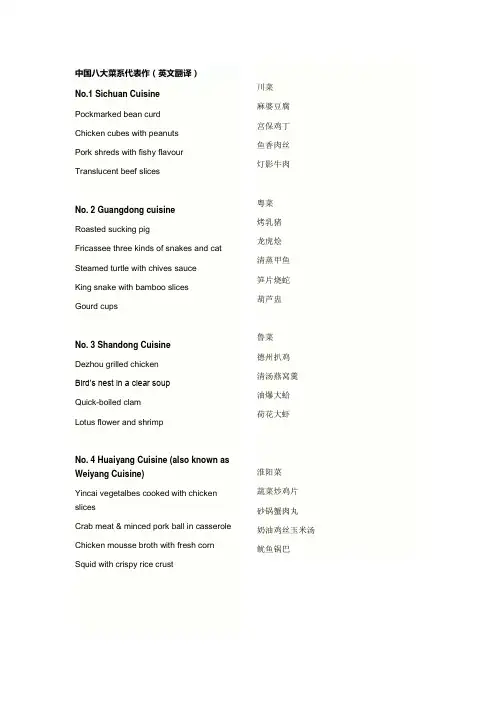
中国八大菜系代表作(英文翻译)No.1 Sichuan CuisinePockmarked bean curdChicken cubes with peanutsPork shreds with fishy flavour Translucent beef slicesNo. 2 Guangdong cuisineRoasted sucking pigFricassee three kinds of snakes and cat Steamed turtle with chives sauceKing snake with bamboo slicesGourd cupsNo. 3 Shandong CuisineDezhou grilled chickenBird’s nest in a clear soupQuick-boiled clamLotus flower and shrimpNo. 4 Huaiyang Cuisine (also known as Weiyang Cuisine)Yincai vegetalbes cooked with chicken slicesCrab meat & minced pork ball in casserole Chicken mousse broth with fresh corn Squid with crispy rice crust 川菜麻婆豆腐宫保鸡丁鱼香肉丝灯影牛肉粤菜烤乳猪龙虎烩清蒸甲鱼笋片烧蛇葫芦盅鲁菜德州扒鸡清汤燕窝羹油爆大蛤荷花大虾淮阳菜蔬菜炒鸡片砂锅蟹肉丸奶油鸡丝玉米汤鱿鱼锅巴No. 5 Zhengjiang CuisineDong po porkWest lake vinegar fishShelled shrimps with dragon well tea leavesBeggar’s chicken( a whole chicken roasted in a caked mud)No. 6 Fujian cuisineSea food and poultry in casserole Steamed chicken ball with egg-whiteFried prawn shaped as a pair of fishCrisp pomfret with litchiNo.7 Hunan CuisineDong’an chickenBraised dried pork with eel slicesSteamed turtleSpring chicken with cayenne pepperNo. 8 Anhui CuisineHuangshan stewed pigeonGourd duckFricassee pork sinew with egg whiteCrisp pork with pine nuts 浙菜东坡肘子西湖醋鱼龙井虾肉叫花鸡闽菜红烧鱼翅芙蓉鸡丸油炸对虾荔枝鲳鱼湘菜东安鸡红烧肉清蒸海龟辣子鸡丁徽菜黄山醉鸽葫芦鸭蛋花炖肉松仁排骨。
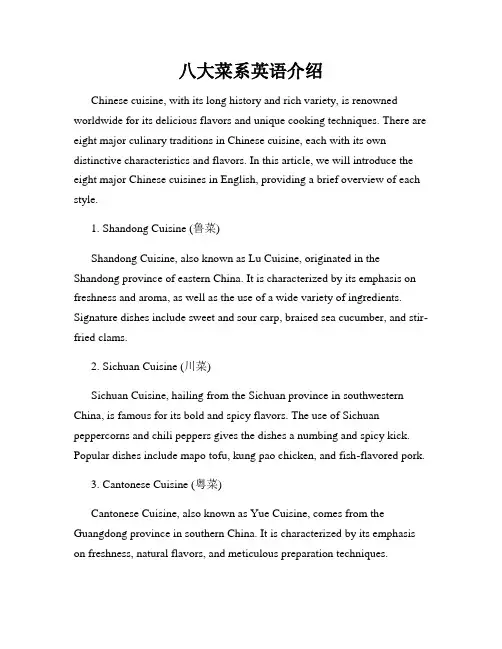
八大菜系英语介绍Chinese cuisine, with its long history and rich variety, is renowned worldwide for its delicious flavors and unique cooking techniques. There are eight major culinary traditions in Chinese cuisine, each with its own distinctive characteristics and flavors. In this article, we will introduce the eight major Chinese cuisines in English, providing a brief overview of each style.1. Shandong Cuisine (鲁菜)Shandong Cuisine, also known as Lu Cuisine, originated in the Shandong province of eastern China. It is characterized by its emphasis on freshness and aroma, as well as the use of a wide variety of ingredients. Signature dishes include sweet and sour carp, braised sea cucumber, and stir-fried clams.2. Sichuan Cuisine (川菜)Sichuan Cuisine, hailing from the Sichuan province in southwestern China, is famous for its bold and spicy flavors. The use of Sichuan peppercorns and chili peppers gives the dishes a numbing and spicy kick. Popular dishes include mapo tofu, kung pao chicken, and fish-flavored pork.3. Cantonese Cuisine (粤菜)Cantonese Cuisine, also known as Yue Cuisine, comes from the Guangdong province in southern China. It is characterized by its emphasis on freshness, natural flavors, and meticulous preparation techniques.Cantonese cuisine is known for its delicate flavors and use of fresh seafood. Signature dishes include dim sum, sweet and sour pork, and steamed fish.4. Hunan Cuisine (湘菜)Hunan Cuisine, from the Hunan province in central China, is renowned for its bold and spicy flavors. It is similar to Sichuan Cuisine but uses more chili peppers and garlic, resulting in a fiery and aromatic taste. Signature dishes include orange beef, spicy frog legs, and steamed fish head.5. Jiangsu Cuisine (苏菜)Jiangsu Cuisine, also known as Su Cuisine, originates from the Jiangsu province in eastern China. It is characterized by its emphasis on color, aroma, taste, and presentation. Jiangsu cuisine features delicate flavors and exquisite cooking techniques. Signature dishes include sweet and sour spare ribs, braised pork belly, and crystal shrimp dumplings.6. Zhejiang Cuisine (浙菜)Zhejiang Cuisine, from the Zhejiang province in eastern China, is known for its fresh and tender flavors. It emphasizes the use of fresh seafood, bamboo shoots, and other local ingredients. Zhejiang cuisine is light, refreshing, and often features delicate flavors. Signature dishes include Dongpo pork, West Lake vinegar fish, and beggar's chicken.7. Fujian Cuisine (闽菜)Fujian Cuisine, from the Fujian province in southeastern China, is known for its emphasis on umami flavors and seafood. It features a combination of sweet, sour, salty, and savory tastes. Fujian cuisine is knownfor its soups, seafood dishes, and delicate flavors. Signature dishes include Buddha Jumps Over the Wall, drunken chicken, and oyster omelette.8. Anhui Cuisine (徽菜)Anhui Cuisine, from the Anhui province in eastern China, is known for its emphasis on wild and natural ingredients. It features braising, stewing, and steaming techniques to highlight the natural flavors of the ingredients. Anhui cuisine is hearty, rustic, and nutritious. Signature dishes include Beggar's Chicken, Huangshan braised tofu, and fried mandarin fish.In conclusion, Chinese cuisine is incredibly diverse and offers a range of flavors and cooking styles to suit every palate. The eight major Chinese cuisines each have their own unique characteristics and history, showcasing the culinary traditions of China. Whether you prefer spicy Sichuan dishes, delicate Cantonese dim sum, or hearty Anhui cuisine, there is something for everyone to enjoy in Chinese cuisine.。
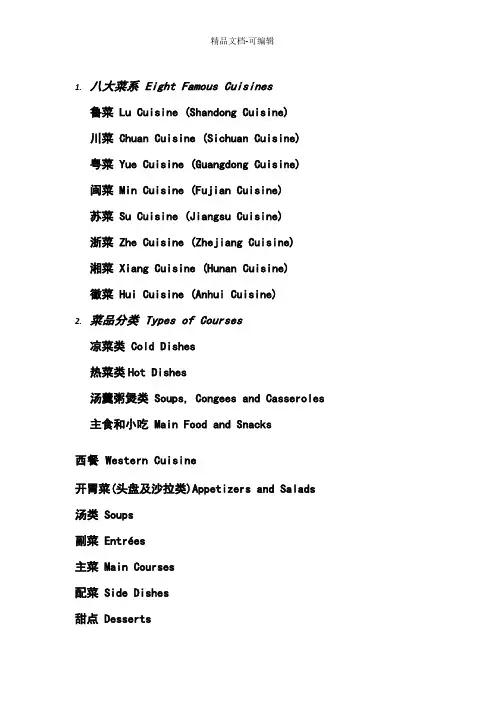
1.八大菜系 Eight Famous Cuisines鲁菜 Lu Cuisine (Shandong Cuisine)川菜 Chuan Cuisine (Sichuan Cuisine)粤菜 Yue Cuisine (Guangdong Cuisine)闽菜 Min Cuisine (Fujian Cuisine)苏菜 Su Cuisine (Jiangsu Cuisine)浙菜 Zhe Cuisine (Zhejiang Cuisine)湘菜 Xiang Cuisine (Hunan Cuisine)徽菜 Hui Cuisine (Anhui Cuisine)2.菜品分类 Types of Courses凉菜类 Cold Dishes热菜类Hot Dishes汤羹粥煲类 Soups, Congees and Casseroles 主食和小吃 Main Food and Snacks西餐 Western Cuisine开胃菜(头盘及沙拉类)Appetizers and Salads 汤类 Soups副菜 Entrées主菜 Main Courses配菜 Side Dishes甜点 Desserts饮品Drinks一、酒精类饮品 Alcoholic Beverages1. 国酒 Chinese Wines2. 洋酒 Imported Wines白兰地与威士忌 Brandy and Whisky金酒与朗姆酒 Gin and Rum伏特加与龙舌兰 Vodka and Tequila利口酒和开胃酒 Liqueurs and Aperitifs红酒 Red Wine二、不含酒精类饮品 Non-Alcoholic Beverages三、中国饮品文化 Chinese Drinking Culture1. 中国茶文化 Chinese Tea Culture2. 中国酒文化 Chinese Wine Culture一.翻译原则1以主料为主,配料或配汁为辅的翻译原则1.菜肴的主料和配料主料(名称/形状)+with+配料如:松仁香菇Chinese Mushrooms with Pine Nuts2.菜肴的主料和配汁主料with /in+汤汁(Sauce)如:冰梅凉瓜Bitter Melon in Plum Sauce2二.以烹制方法为主,原料为辅的翻译原则1.菜肴的做法和主料做法(动词过去分词)+主料(名称/形状)如:拌双耳 Tossed Black and White Fungus2.菜肴的做法、主料和配料做法(动词过去分词)+主料(名称/形状)+配料如:豌豆辣牛肉 Sautéed Spicy Beef and Green Peas3.菜肴的做法、主料和汤汁做法(动词过去分词) + 主料(名称/形状)+with /in+汤汁如:川北凉粉 Tossed Clear Noodles with Chili Sauce三.以形状、口感为主,原料为辅的翻译原则1.菜肴形状或口感以及主配料形状/口感+ 主料如:玉兔馒头Rabbit-Shaped Mantou脆皮鸡 Crispy Chicken2.菜肴的做法、形状或口感、做法以及主配料做法(动词过去分词)+ 形状/口感 + 主料 + 配料如:小炒黑山羊 Sautéed Sliced Lamb with Pepper and Parsley3以人名、地名为主,原料为辅的翻译原则1.菜肴的创始人(发源地)和主料人名(地名)+ 主料如:麻婆豆腐 Mapo Tofu (Sautéed Tofu in Hot and Spicy Sauce)广东点心 Cantonese Dim Sum4.介绍菜肴的创始人(发源地)、主配料及做法做法(动词过去式)+ 主辅料+ 人名/地名+ Style如:四川辣子鸡Spicy Chicken, Sichuan Style北京炸酱面 Noodles with Soy Bean Paste, Beijing Style5体现中国餐饮文化,使用汉语拼音命名或音译的翻译原则 1.具有中国特色且被外国人接受的传统食品,本着推广汉语及中国餐饮文化的原则,使用汉语拼音。
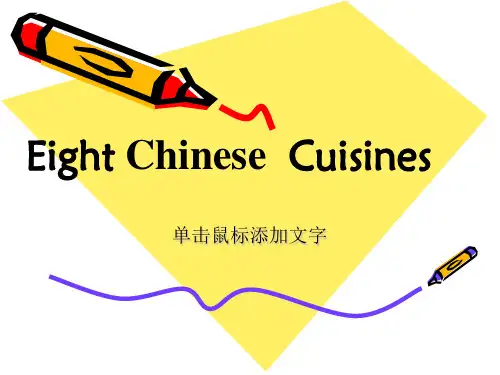
Regional cuisines Eight Cuisines八大菜系Sichuan Cuisine 川Jiangsu Cuisine 苏Cantonese cuisine 粤Shandong cuisine 鲁Fujian Cuisine 闽Zhejiang Cuisine 浙Hunan cuisine 湘Anhui Cuisine 皖No. 1 Sichuan Cuisine川菜Pockmarked bean curd(豆腐) 麻婆豆腐Chicken cubes with peanuts 宫保鸡丁Pork shreds with fishy flavour 鱼香肉丝Translucent beef slices 灯影牛肉Twice-cooked pork 回锅肉chili pepper chicken 辣子鸡No. 2 Guangdong cuisine粤菜Roasted sucking pig 烤乳猪Fricassee(油焖) three kinds of snakes and cat 龙虎烩Steam turtle with chives(香葱) sauce 清蒸甲鱼King snake with bamboo slices 笋片烧蛇Gourd cups葫芦盅No. 3 Shandong Cuisine鲁菜Dezhou grilled chicken 德州扒鸡Bird's nest in a clear soup 清汤燕窝羹Quick-boiled clam 油爆大蛤Lotus flower shrimp(虾) 荷花大虾No. 4 Huaiyang Cuisine苏菜/淮扬菜Crab(蟹) meat & minced(切成末的) pork ball in casserole(砂锅) 砂锅蟹肉丸Chicken mousse(奶油) broth(汤) with fresh corn奶油鸡丝玉米汤Squid(鱿鱼) with crispy rice crust(粑) 鱿鱼锅巴No. 5 Zhengjiang Cuisine浙菜Dongpo pork 东坡肘子West lake vinegar(醋) fish 西湖醋鱼Shelled shrimp (虾仁) with dragon well tea leaves 龙井虾仁Beggar’s chicken 叫花鸡No. 6 Fujian cuisine闽菜Sea food and poultry(家禽) in casserole 佛跳墙Steamed chicken ball with egg-white 芙蓉鸡丸Fried prawn(对虾) shaped as a pair of fish油炸对虾Crisp pomfret(鲳鱼) with litchi(荔枝) 荔枝鲳鱼No.7 Hunan Cuisine湘菜Dongan chicken 东安鸡Braised dried(红烧) pork with eel(鳗鱼) slices 红烧肉Steamed turtle 清蒸甲鱼Spring chicken with cayenne(红椒) pepper 麻辣仔鸡No. 8 Anhui Cuisine皖菜/徽菜Huangshan stewed pigeon 黄山醉鸽Gourd duck葫芦鸭Fricassee(油焖) pork sinew(腱) with egg white蛋花炖肉Crisp pork with pine nuts(松仁) 松仁排骨Other regional cuisine:其它菜系Hot pots /Chongqing hotpot 重庆火锅Muslim cuisine 清真菜Imperial-Simulating(仿皇室的) cuisine 仿膳菜Vegetarian cuisine素菜Northeastern cuisine东北菜Taiwan snack台湾小吃Famous delicacy:名菜北京烤鸭Beijing duck羊肉串Kebab狗不理包子Goubuli steamed stuffed bun; dumb dog dumpling过桥米线Crosses the bridge rice-flour noodle担担面dan dan mian (noodles in spicy garlic sauce)夫妻肺片Fuqi ox lung slice红烧蹄筋braised tendon with brown sauce麻婆豆腐Mapo bean curd西湖醋鱼West Lake sour and sweet fish水煮肉片stewed pork slices东坡肘子pork joint cooked in Su Dongpo's style鱼香肉丝shredded pork in fish flavored sauceStaple主食The staple food of Chinese is rice and flour. Southerners prefer rice and ground rice products, such as cooked rice, New Year rice cake, eight treasure rice pudding, and rice dumpling while northerners prefer cooked wheaten food. With wheat flour, they make steamed bread, stuffed bun, various kinds of noodles, and meat dumpling, etc.译文:中国人的主食以大米和面为主,南方人多吃大米和米粉制品,如米饭、年糕、八宝饭、汤圆。
中国八大菜系英语作文(中英文版)**English Version:**China is renowned for its rich and diverse culinary heritage, among which the "Eight Major Cuisines" stand out as the most representative.These cuisines embody the unique flavors, cooking techniques, and cultural traditions of different regions in China.1.**Sichuan Cuisine**: Famous for its spicy and bold flavors, Sichuan cuisine employs a variety of chili peppers and the Sichuan peppercorn to create its distinctive numbing and hot taste.Classic dishes include Mapo Tofu and Hot Pot.2.**Cantonese Cuisine**: Originating from Guangdong Province, Cantonese cuisine is celebrated for its delicate flavors and fresh ingredients.It is characterized by its wide range of cooking methods, such as stir-frying, steaming, and roasting.Dim Sum and Roast Goose are iconic dishes.3.**Shandong Cuisine**: As the cuisine of Confucius" hometown, Shandong cuisine emphasizes on the harmony between food and the seasons.It is known for its use of seafood due to the province"s coastal location.Fish in Vinegar Gravy and Braised Sea Cucumber are popular dishes.4.**Huaiyang Cuisine**: Hailing from the region around the lowerreaches of the Huai River, this cuisine is known for its light and fresh taste, as well as intricate cooking techniques.Sugar and Vinegar Spare Ribs and Wuxi Spare Ribs are famous examples.5.**Zhejiang Cuisine**: Often called "the cuisine of the scholars," Zhejiang cuisine is known for its delicate flavors and pursuit of natural tastes.West Lake Fish in Vinegar Gravy and Hangzhou-style Fried Shrimp are must-try dishes.6.**Fujian Cuisine**: Fujian cuisine focuses on the umami taste, achieved through the use of seafood and various types of fungi.It is also famous for its "Buddha Jumping Over the Wall" soup, a complex and aromatic dish.7.**Hunan Cuisine**: Similar to Sichuan cuisine, Hunan cuisine is also known for its spiciness, but it uses different types of chili peppers and cooking methods.Smoked and Fried Tofu with Spicy Sauce is a classic dish.8.**Anhui Cuisine**: Anhui cuisine is famous for its use of wild ingredients from the mountainous region, as well as the employment of smoking and stewing techniques.Deer Horn Glazed with Sugar and Stewed Fish with Tofu are representative dishes.Each of these Eight Major Cuisines offers a unique gastronomic experience, reflecting the diverse and profound culinary culture of China.**中文版本:**中国的饮食文化博大精深,其中“八大菜系”最具代表性,它们分别体现了中国不同地区的风味特色、烹饪技艺和文化传统。
八大菜系的作文英语英文回答:The Eight Culinary Traditions of China.China's culinary landscape is as diverse as its vast terrain, with each region boasting its own unique culinary traditions. These eight distinct cuisines have shaped the nation's gastronomic heritage, showcasing the rich flavors, innovative techniques, and cultural influences that have defined Chinese cuisine over centuries.1. Shandong Cuisine (鲁菜)。
Renowned for its use of seafood, Shandong cuisine emphasizes freshness and simplicity. Steamed fish, stir-fried dishes, and soups showcase the natural flavors of local ingredients.2. Sichuan Cuisine (川菜)。
Bold and fiery, Sichuan cuisine is known for its use of chili peppers, garlic, and other spicy ingredients. Mapo tofu, twice-cooked pork, and kung pao chicken are iconic dishes that exemplify the region's fiery flavor profile.3. Cantonese Cuisine (粤菜)。
Sichuan CuisineBean curd with mince and chilli oil 麻婆豆腐Braised pork knuckle with bean sauce豆瓣全肘Diced chicken with chilli pepper ; chicken cubes with peanuts宫保鸡丁Pork shreds with fishy flavour ;shredded pork,in Sichuan style鱼香肉丝Stewed scallop and turnip ball绣球干贝Steamed pork wrapped in lotus leaves 荷叶蒸肉Translucent beef slices灯影牛肉Spicy Sichuan-style tender chicken slices怪味鸡块Shrimp with green vegetables翡翠虾仁“chrysanthemum” in chafing dish 菊花火锅Shandong CuisineBird’s nest in clear soup清汤燕窝Braised sea whelks in brown sauce红烧海螺Dezhou grilled chicken德州扒鸡Braised sea slug with crab meat in brown sauce蟹烧海参Chinese yam in hot toffee拔丝山药Quick-boiled clam油爆大蛤Lotus flower,and shrimp荷花大虾Guangdong CuisineSweet-sour pork fillet with chilli 糖醋咕噜肉Sliced chicken with oyster sauce耗油滑鸡片Fricassee three kinds of snakes and cat三蛇龙虎会Shark’s fin with crab ovum虾黄鱼翅Roasted sucking pig烤乳猪Stewed crab meat and eggplant虾肉烧茄子Steamed turtle with chive sauce美味蒸甲鱼Stuffed duck shaped as gourd八珍葫芦鸭Crisp-skinned chicken脆皮鸡King snake with bamboo slices竹丝烩王蛇Gourd cups冬瓜盅Fujian CuisineSea food and poultry in casserole佛跳墙Steamed pork roll with rice flour and lotus leaf荷叶米粉肉Crisp pomfret with litchi荔枝鲳鱼Steamed chicken ball with egg-white蒸芙蓉鸡球Fried prawn shaped as a pair of fish太极明虾Sauté shredded whelks in rice wine sauce炝糟响螺Sauté sea cucumber with scallions葱烧刺参Fricassee shark’s fin with chicken白烧大翅Jiangsu CuisineYincai vegetables cooked with chicken slices银菜鸡丝Braised meat with vegetables & wine百菜酒焖肉Scallop wrapped in chicken breast slices鸡片包干贝Braised stuffed crucian carp荷包鲫鱼Stuffed pork breast with pine kernels松子肉Squid with crispy rice crust鱿鱼锅巴Crab meat & minced pork ball in casserole蟹粉狮子头Finless eel tail with grated garlic炝虎尾Chicken mousse broth with fresh corn 鸡茸玉米Fricassee ox tendon白汁牛人Zhejiang CuisineWest Lake water shield soup西湖莼菜汤Eight-jewel rice pudding wrapped with lotus leaves八宝荷叶饭 Beggar’s chicken 叫花鸡Dongpo pork东坡肉West Lake vinegar fish 西湖醋鱼Shelled shrimp with Dragon Well tea leaves 龙井虾仁Pork meat patties with crab meat蟹粉狮子头Hunan CuisineSteamed fried pork in black bean sauce 走油豆豉扣肉Dong’an chicken东安鸡Crispy rice crust with sea cucumber锅巴海参Spring chicken with cayenne pepper麻辣子鸡Steamed turtle清蒸甲鱼White bait in chafing dish银鱼火锅Braised sh ark’s fin in brown sauce红煨鱼翅Sweet lotus seed冰糖湘莲Anhui CuisineHuangshan stewed pigeon黄山炖鸽Fricassee pork sinew (tendon )with egg white芙蓉蹄筋Crispy pork with pine nuts松子米酥肉Fuliji stewed chicken符离集烧鸡Spicy fried chicken椒盐米鸡Gourd duck葫芦鸭子。
A bite of ChinaIntroductionHave you heard of “A bite of China”? There are 8 major cuisines in china. They are Shandong Cuisine, Cantonese Cuisine, Sichuan Cuisine, Anhui Cuisine, Zhejiang Cuisine, Jiangsu Cuisine, Fujian Cuisine, Hunan Cuisine, and so on.The formation of the cuisines can’t depart with its long history and unique cooking method. It also influenced by the local natural conditions and cultural environment. And every cuisine has its own style. Some people described the eight cuisines in a personate way. He said that the Jiangsu Cuisine and Zhejiang Cuisine are like delicate and pretty Jiangnan belle. Shandong Cuisine and Anhui Cuisine are like north and earthy valiant fighter. Cantonese Cuisine and Fujian Cuisine are like romantic and elegant gentleman. Sichuan Cuisine and Hunan Cuisine are like versatile celebrity. For instance, Sichuan Cuisine is known as the most irritant dishes. A famous proverb is that food in China and taste in Sichuan. It has a very spicy taste. Shandong Cuisine is known as the most influential dishes because it is the represent of north dishes. The ingredients of Cantonese Cuisine is extensive and rare, so people said there is nothing can’t be eaten in this cuisine. Anhui Cuisine has a good name is that find the lost delicacy. Because the main ingredients of this cuisine are less polluted products in mountainous area. In this book , six of the famous cuisines will be shown, and some specialties and famous restaurants will be recommended. It can help you to understand the cooking culture of China. And if you travel to China, it can help you to choose your favorite food. So you can have a cate enjoyment. Now, let’s open the gate of Chinese Cuisines.Shandong Cuisine (July)Shandong Cuisine, which is originated from Shandong flavor, always clean, pure, and not greasy. Shallot and garlic are two main seasonings of the dishes, so Shandong Cuisine usually tastes pungent. It emphasizes on tenderness, crispness and freshness. Jinan cuisine and jiaonan cuisine are the two main parts of Shandong Cuisine. Jinan cuisine characterizes by deep-frying and stir-frying, grilling, and stir-frying while jiaonan cuisine focuses on cooking food with light taste. Soups are very famous in Shandong Cuisine. If you have a try, you will find that thin soup tastes fresh and creamy soup tastes strong.Shandong is the birthplace of cooking culture, and there ever existed many famous ancient scholars, such as Confucius and Mencius. As old as the ancient scholars, Shandong Cuisine also has a long history. It originated in the Spring and Autumn period , and formed during Qin and Han Dynasty. After Song Dynasty, it became the represent of “the North dishes”. Shandong cuisine is one of the major eight Chinese cuisine and it is the local cuisine that covered most extensive area in China, include Beijing, Tianjin and Dongbei Province.Shandong Province is known as the origination of ancient culture in China. The formation of Shandong Cuisine has a tight connection with the local history, geographical conditions, economic conditions and customs. This province is also known as one of world’s three gardens. For example, jiaozhou Chinese cabbage, Zhangqiu garlic, Cangshan shallot are famous in abroad. There are too many Shandong Cuisine restaurants in china. The most famous restaurants include Qilu renjia, Beijing Qilu Restaurant and Tongheju.Cantonese Cuisine(Asiya)Cantonese Cuisine is one of the eight culinary traditions of Chinese cuisine. When westerners speak of Chinese food, they usually refer to Cantonese Cuisine. Why? This is because of the most Chinese who immigrant and set up restaurants overseas were from Guangdong. Now, let me introduce this kind of cuisine. Guangzhou, the capital of Guangdong province, has long been a trading port and many important food. Unlike other Chinese cuisine style of cooking, Cantonese Cuisine more attention to bring out or highlight the original taste of the meet, vegetable. unlike Sichuan Cuisine so spicy, unlike other foods lost original taste of cooking, so Cantonese Cuisine is a little spice or sugar is used generally.Common Cantonese Dishes for you.These dishes are often simple and easy to learn to cook, and they came the most common foods on the menus of Cantonese restaurants.Chinese steamed eggs: there are by beating eggs to a creamy consistency and steaming till this water boiling. Variations are derived by colding different ingredients, such as onion and soy sauce.Noddle dishesShahe noodles are a kind of rice noodles, they are broad and look white, their texture is elastic and like a little chewy. They don’t freeze or drying and should generally purchased fresh in strips that should be cut to the desired width. Shahe noodles are popular in southern china.Meat Dishes.We should boil the chicken in water until the chicken looks golden. When it is cook done, the chicken tastes fresh and maintain original taste of chicken.Seafood.Because Guangdong located on the southern of china, fresh seafood is easy to available to get and many Cantonese restaurants are best use of this advantages. In Cantonese culinary arts, steaming is best cooking style. According to Cantonese Cuisine, the taste fresh is the most important point, so seafood generally cooked by steaming.Cantonese are known to us that they try different kind of meats and vegetables. So, people those who are in Northern China often says that Cantonese people will eat anything that flies except airplanes, anything that moves on the ground except train, and everything that moves in the water except boats.Panxi restaurant in Guangzhou.Address: 151 west longjin road, Liwan District.Lung king HeenAddress: IFC Tower, 8 Finance st, Hong Kong.Zhejiang cuisine(Clark)Zhejiang cuisine also called Zhe Cai for short, is one of the eight major cuisines of China. Zhejiang cuisine has it’s unique taste and unique cooking method. It’s because that Zhejiang province be rich in natural resources. Zhejiang province closed to sea, so Zhejiang cuisine is good at making sea food, and Zhejiang province also is the main place that product meat and rice, so the meat also is the Zhejiang cuisine’s material. So Zhejiang cuisine’s cooking methods mainly are sautéing, stir-frying, simmering and steaming, obtaining the natural flavor and taste. Zhejiang cuisine, not greasy, wins its reputation for freshness, tenderness and smoothness of its dishes with mellow fragrance.Zhejiang cuisines include Hangzhou food, Ningbo food and Shaoxing food. Hangzhou, Ningbo and Shaoxing are all in Zhejiang Province. Hangzhou food is the most famous cuisine in the Zhejiang cuisine.Hangzhou food tastes fresh and crisp, and with the change of season it also has different kinds of food. And the main cooking methods of Hangzhou food are sautéing stewing, deep-frying and steaming. Ningbo food is a bit salty but delicious. And Ningbo food is good at steaming, roasting and braising seafood, so Ningbo food famous by retaining original freshness, tenderness and softness. Shaoxing food known as it’s aquatic food and poultry. Shaoxing food has a unique village flavor, smell sweet taste soft and glutinous, thick in gravy and strong in season.Zhejiang cuisine specializes in stir-frying, steaming, deep-frying and simmering, obtaining the natural flavor and taste. And Zhejiang province has full of materials, and people take special carein cooking, so Zhejiang cuisine is so delicious and be famous in China.Anhui Cuisine (Angenla)Anhui cuisine, together with Shan dong cuisine, Sichuan cuisine, Cantonese cuisine, Zhejiang cuisine and Jiangsu cuisine are all belonged to Chinese royal dishes from Qin dynasty. They all pay attention to the cultured colors and fresh materials.It is said that the emperor Yuan collected public opinions from Anhui and Zhejiang provinces when he unified southern China in 221B、C. He happened to be invited to a village when he passes by Anhui province. Although the villagers did not recognize his identify, they treated him with generous hospitality and did him a meal with fresh seafood and home-made chili sauce. When the emperor Yuan came back to the capital, he missed that taste and the people there. To memorize villagers’ kindness and this moved experience, he named it Hui cuisine and listed Anhui cuisine as one of the eight major components of Chinese cuisine.The most famous dish of Anhui cuisine called “Boiled fish”. They put the raw fish into boiled chili oil and add green onion, ginger, garlic and soy to it. Wait your raw ingredients are slow-cooked in a safe, enclosed cooker for 20minutes and a delicious boiled fish is born! Have a taste, you can feel the fish with hot sauce is melted in your mouth.Southern cuisines like to use seafood and chilies to make the foods have strong taste. Similarly,traditional Anhui cuisine as a part of southern cuisine also use fierce ingredients to awakening the gastricfire .On completely contrast, northern cuisine ,like Shandong cuisine are light and use chilies and pepper as less as they can.However, because of the big differences between southern cuisines and northern cuisines, Chinese dietary culture appears to be rich and varied.Jiangsu Cuisine(Belle)Jiangsu cuisine, which is abbreviated to su cuisine, is one of the eight cuisines of Chinese mainly nationality. It was invented two thousand years ago. Jiangsu cuisine is similar to the Zhejiang cuisine. They are both also called the land of fish and rice because of the much water there. Jiangsu province and Zhejiang province are located in the south of China and beside the sea, so there are a lot of rainfall in Jiangsu and Zhejiang. Therefore, some delicious food is made of fish in Jiangsu and Zhejiang province. On the other hand, Jiangsu cuisine is different from Zhejiang and the other places. Its characteristic is thick with light, crisp and fresh juice broth strong but not greasy, gentle, salty and sweet. The cookers in Jiangsu are good at stewing, braising, burning, heating and frying. In addition, they are skilled in cooking soup that taste very fresh. What is the most representative are Suzhou dish, Yangzhou dish, Nanjing dish and Zhenjiang dish. Suzhou food taste sweet and its color slants harmony. Yangzhou cuisine has light material, fine mellow flavor and knife labor. Nanjing and Zhejiang dish focus on alcohol which make the dishes have exquisite dainty, especially in the prestigious duck dishes. In a word, Jiangsu cuisine is famous for its colorful selection of ingredients, its meticulous preparation methodology and its not-too- bland taste.Sichuan cuisine(Betty)Sichuan cuisine is one of the most famous Chinese cuisine originating from Sichuan province ,and it is widely distributed through China. It has flavors mainly the pungency and spiciness because of a lot of garlic and hot peppers liberally used. Within developing, it has been divided into four specious include Chongqing, Chengdu, Zigong, and Buddhist vegetarian style because of the different area and religion. Most tourists usually choose to go to Chengdu, so in this part, you will see some famous dishes and restaurants in Chengdu. Kung Pao chicken, Mapo tofu, Fuqi feipian, Dandan noodles are the three dishes recommended. Chengdu.Kung Pao chicken isstir-fried with chicken, peanuts, vegetables, and chili peppers. Mapo doufu is powerfully heat and spicy.It consists of tofu set in a spicy and salt flavor, and often cooked with minced meatusually (pork or beef)and douchi (fermented black beans).Fuqi feipian, actual lung is rarely used despite its name, originated in the qing dynasty. Dandan nuddles is another classic Sichuan dish that one shouldn’t miss out when you’re in Chengdu. The one thing you’ll find in every recipe for Dan Dan Noodles is a spicy sauce that includes sesame paste and hot chili oil. Mr. Chen mapo tofu,chain of fuqifeipian are the two restaurants recommended. Most Szechuan dishes are spicy, although a typical meal includes non-spicy dishes. Sichuan cuisine is composed of seven basic flavors: sour, pungent, hot, sweet, bitter, aromatic, and salty. If you don’t like the bold flavors, you can try other dishes without pungent, hot or sour. But if you don't try one of the several kinds of food, you'll regret it.。